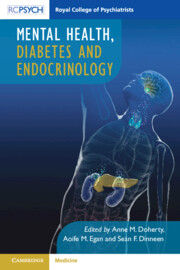Book contents
- Mental Health, Diabetes and Endocrinology
- Mental Health, Diabetes and Endocrinology
- Copyright page
- Contents
- Contributors
- Preface
- Chapter 1 An Introduction to Psychiatry in Endocrinology
- Chapter 2 Depression across Endocrine Disorders
- Chapter 3 Antipsychotic Medications and Metabolic Syndrome
- Chapter 4 ‘Diabulimia’, Diabetes and Eating Disorders
- Chapter 5 Disorders of the Hypothalamic–Pituitary–Adrenal Axis
- Chapter 6 Disorders of the Thyroid and Parathyroid
- Chapter 7 Psychological Factors Impacting on Endocrine Disorders and Self-Management and Medication-Taking Behaviour
- Chapter 8 Cognitive Impairment and Endocrine Conditions
- Chapter 9 Suicidal Ideation and Self-Harm
- Chapter 10 Obesity and Mental Health
- Chapter 11 Gender Incongruence
- Chapter 12 Anti-androgens in Forensic Psychiatric Settings
- Chapter 13 Service- and Setting-Related Challenges
- Index
- References
Chapter 7 - Psychological Factors Impacting on Endocrine Disorders and Self-Management and Medication-Taking Behaviour
Published online by Cambridge University Press: 14 October 2021
- Mental Health, Diabetes and Endocrinology
- Mental Health, Diabetes and Endocrinology
- Copyright page
- Contents
- Contributors
- Preface
- Chapter 1 An Introduction to Psychiatry in Endocrinology
- Chapter 2 Depression across Endocrine Disorders
- Chapter 3 Antipsychotic Medications and Metabolic Syndrome
- Chapter 4 ‘Diabulimia’, Diabetes and Eating Disorders
- Chapter 5 Disorders of the Hypothalamic–Pituitary–Adrenal Axis
- Chapter 6 Disorders of the Thyroid and Parathyroid
- Chapter 7 Psychological Factors Impacting on Endocrine Disorders and Self-Management and Medication-Taking Behaviour
- Chapter 8 Cognitive Impairment and Endocrine Conditions
- Chapter 9 Suicidal Ideation and Self-Harm
- Chapter 10 Obesity and Mental Health
- Chapter 11 Gender Incongruence
- Chapter 12 Anti-androgens in Forensic Psychiatric Settings
- Chapter 13 Service- and Setting-Related Challenges
- Index
- References
Summary
The majority of endocrine conditions can be successfully managed with long-term treatment, whether that be in the form of medication or lifestyle factors. In order for treatment to be effective, adherence to the treatment regime is key. Central to the concept of adherence is the presumption of an agreement between prescriber and patient about the prescriber’s recommendations. Non-adherence occurs when a patient does not initiate a new prescription, implement it as prescribed or persist with treatment. The World Health Organization (WHO) has posited that, in general, there are five dimensions to adherence, all of which can impact on rates of non-adherence: condition-related factors, health system factors, socio-economic factors, therapy-related factors and patient-related factors. While these dimensions are not entirely independent of each other, this serves as a useful means for organising the broad range of factors that can contribute to non-adherence.
- Type
- Chapter
- Information
- Mental Health, Diabetes and Endocrinology , pp. 68 - 80Publisher: Cambridge University PressPrint publication year: 2021



